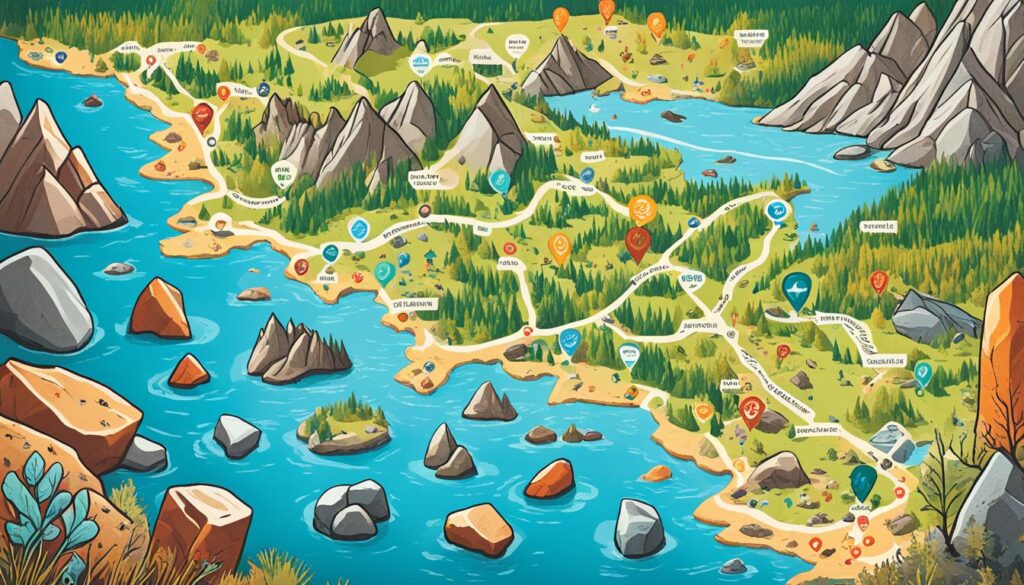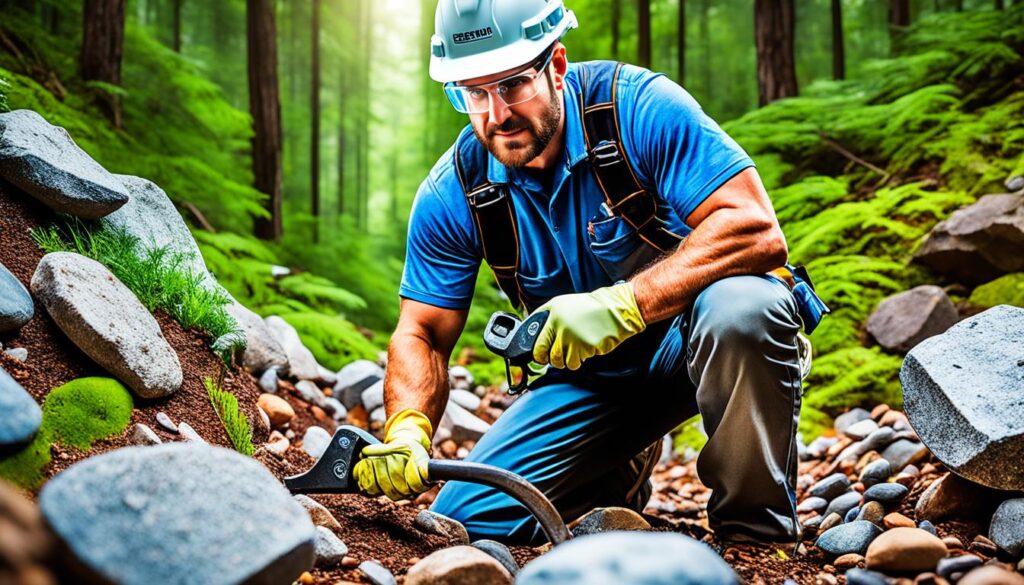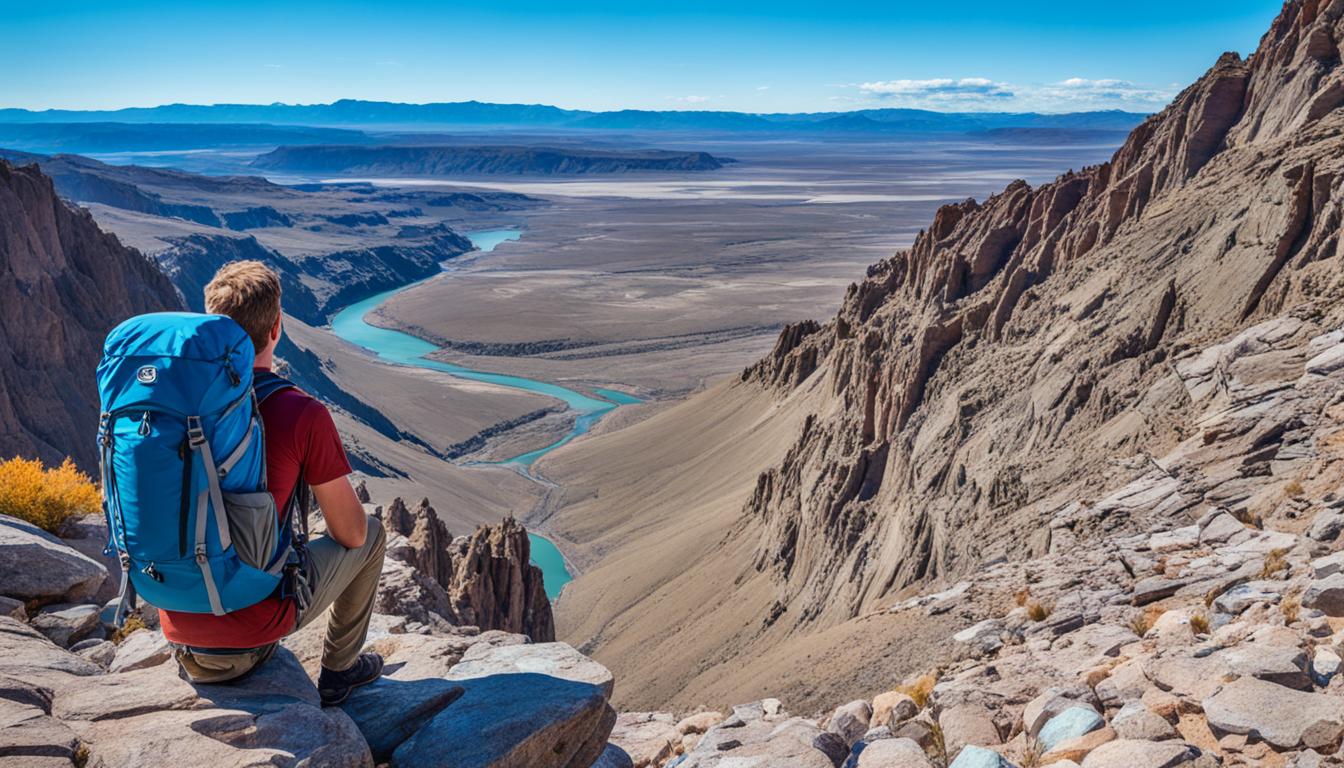This post contains affiliate links.
Imagine standing at the foot of a mountain, a hammer in hand and the horizon stretching wide before you. You’re about to embark on an adventure, not just any adventure, but one that taps into the very foundations of the Earth. Rockhounding isn’t merely a hobby; it’s a doorway to the past, a hands-on encounter with the planet’s rich tapestry of minerals and gems. Whether climbing over a craggy outcrop, eagerly scanning the ground for the glint of a quartz vein, or kneeling beside a stream sifting through the pebbles, this is where your geological adventures unfold. In the search for rockhounding treasures, every step brings a story, and every find adds a verse – you’re not just searching for rocks; you’re uncovering the very bones of the Earth.
As an enthusiast, your quest begins with the essential question: where to find rocks for rockhounding? Through this rockhounding guide, we aim to set you on a path lined with geological wonders to fuel your thirst for discovery. Let’s prepare to step into nature’s gallery, where the exhibits are ageless, and the thrill of pursuit matches the joy of the find. Welcome to the grand hunt for rockhounding treasures.
Key Takeaways
- Rockhounding connects you with Earth’s history through hands-on exploration.
- Your geological adventures can lead to the discovery of sparkling minerals and precious gems.
- The heart of rockhounding beats strongest where geological activity has left its mark.
- Beginners and veterans alike can find joy in the anticipation of finding rockhounding treasures.
- The essence of where to find rocks for rockhounding lies in understanding and respecting natural landscapes.
- An effective rockhounding guide can transform your searches into successful and rewarding experiences.
The Allure of Rockhounding
The seductive pull of rockhounding lies in its mix of outdoor adventure and the thrill of discovery. Whether you’re scaling craggy peaks in search of geodes or sifting through riverbeds for glistening gold, the hobby transcends mere pastime; it becomes a passionate quest for Earth’s hidden jewels. In the midst of nature’s vast canvas, every rockhound’s heart beats for the chance to uncover the next spectacular find.
For every enthusiast looking to start their rockhounding journey, knowing the best places for rockhounding can make all the difference. These locations not only promise abundant riches but also offer a breathtaking backdrop for your geological explorations.
Embracing the Rockhound’s Journey
Embarking on rockhounding adventures can lead you to some of the most stunning and geologically rich terrains in the world. Imagine trekking through the open wilderness where each step brings you closer to unearthing minerals that have ornamented the Earth for eons. As you embrace the rockhound’s journey, remember that it’s as much about the thrill of finding your first garnet in the wild as it is about the stories and experiences each rockhounding spot offers along the way.
Understanding the Appeal of Geological Exploration
What is it that lures enthusiasts to remote rockhounding destinations? It’s the inherent curiosity to delve into the chronicles etched in stone and sediment—from fossils that whisper tales of prehistoric life to agates that glisten like jewels of the night sky. Learning the language of the terrain and its secrets is the ultimate reward, and with a few essential rockhounding tips, you can begin to unlock the geological stories written across the fabric of time.
As your collection grows and your expertise deepens, you’ll find that rockhounding is more than a hobby; it’s a lifetime’s journey of learning and appreciation for the natural world. So, strap on your boots, grab your hammer, and prepare to step into a realm where every stone has a story to tell.
Rockhounding Essentials: Gearing Up for Your Expedition
Preparing for a rockhounding adventure offers both excitement and the potential for significant geological finds. To enhance your experience at various rockhounding locations, it’s essential to pack the right gear. A considered selection of equipment paves the way for not only the discovery but also for taking care of your collected specimens. Here’s a rundown of the essential rockhounding gear you’ll need:
- Rock Hammer: The quintessential tool for any mineral and fossil hunter. Be sure to choose one with a pointed tip on one end for chipping away small areas and a flat head on the other for breaking rocks.
- Durable Backpack: Opt for a sturdy backpack that can endure the rugged terrains and carry your tools and finds safely.
- Magnifying Loupe: This small yet powerful hand lens is indispensable for examining the details of your discoveries up close.
- Field Guide: Equip yourself with a comprehensive field guide to help identify rocks, minerals, and fossils.
- Snacks and Water : Keep your energy up and stay hydrated throughout the day, as rockhounding can be an exhaustive endeavor.
An essential aspect to consider is how each tool plays a unique part in your rockhounding adventure. From the practicality of safely transporting your finds to the exciting moment of identifying and examining them up close, each piece of gear enhances your experience. Remember, the more prepared you are, the more enjoyable and fruitful your exploration will be.
Where to Find Rocks for Rockhounding
If you’re eager to engage in rockhounding, discovering rockhounding locations with a rich geological presence is key. The quest for your next big find often lies in knowing where to look. Rockhounding spots can vary greatly, from the sunbaked edges of rivers to the jagged faces of cliffs. Target locations with visible geological formations or a history of mineral findings—nature’s breadcrumbs leading you to the prize.

Road cuts, those exposed vertical faces along highways, can surprisingly become fruitful rockhounding sites. Here, the layers of Earth are on full display, potentially harboring minerals that have been pushed up from the depths below. Likewise, rocky outcrops serve as prime spots, especially when they’re part of ancient flow banding or volcanic activities. These formations might offer specimens such as quartz or agate.
Streambeds are treasure troughs for rockhounds. The constant rush of water uncovers and transports sediment—and hidden within are often semi-precious stones or fossils. Checking rockhounding resources, like geological maps and databases, alongside local collector’s insights can give you an advantage before setting out to these areas.
Seek out quarries as well, which can be goldmines for rock-collecting expeditions. The deep digging associated with quarries may bring to the surface materials that have not seen the light of day for eons. Always remember that safety is crucial, and ensure you have permission to collect in these areas.
- Investigate road cuts for sedimentary and metamorphic rocks.
- Explore rocky outcrops for visible mineral veins and geodes.
- Scour streambeds after heavy rain for freshly uncovered finds.
- Research active and abandoned quarries for unique minerals.
The thrill of rockhounding comes not just from the finds themselves but from the adventure it takes to locate them. With a discerning eye and a bit of geological knowledge, your collection will continue to grow as you journey from one rockhounding spot to another. So grab your gear and set out—nature’s next marvel awaits your discovery.
Digging into the Details: Unearthing Prime Rockhounding Locations
Embarking on a rockhounding expedition immerses you in the thrill of discovery and the anticipation of what geological treasures you may find. As an enthusiast, knowing the best places for rockhounding enhances your chances of success. From the remote desert landscapes to the vibrant waterways, the Earth’s bountiful array of prime rockhounding locations invites you to uncover the secret alcoves that have cradled natural wonders for millennia.
Navigating Natural Habitats for Rock Discovery
Every seeker’s dream is to stumble upon a setting untouched by time, where minerals and gems rest as they have for eons. It’s in these natural habitats for rocks that one will find the most fulfilling quests and the most valuable finds. Picture yourself sifting through the sands of a riverside bank or carefully dissecting the layers of an open mountain face—these are the moments where the world’s geological library unfolds before you.
Unlocking the Secrets of Streambeds and Quarries
Imagine walking alongside a stream, where the gentle flow of water has meticulously sorted and rounded the stones beneath. Here in the streambeds, one can discover a wide variety of agates, jasper, and sometimes even the elusive gold nugget or two. Quarries, too, serve as open treasure chests. Excavations that once served industrial demands now lay bare the inner workings of the planet, giving you access to crystals, geodes, and other subterranean spectacles.
| Location Type | Expected Finds | Rockhound’s Tip |
|---|---|---|
| Streambeds | Agates, Jasper, Petrified Wood | Look for gravel bars after heavy rain. |
| Quarries | Crystals, Geodes, Fossils | Visit after blasting when new material is exposed. |
| Desert Basins | Opal, Turquoise, Meteorites | Explore early morning or late afternoon for the best light. |
| Mountain Outcrops | Quartz, Garnets, Tourmaline | Check for loose rock and safety; use proper tools. |
To make the most of your rockhounding adventure, it’s not only about where to look but how to look. Techniques like observing the soil’s color changes, recognizing rock formations, and understanding the erosional patterns of the landscape, can drastically improve your chances of unearthing hidden gems. Always remember to tread lightly, respect the environment, and leave no trace behind, ensuring that these natural habitats remain undisturbed for future generations of rockhounds.

The Role of Safety in Rockhounding Adventures
Whether you’re an experienced rockhound or a newcomer to this exciting hobby, prioritizing your safety is crucial to enjoy rockhounding expeditions to the fullest. Just as each rock tells a story millions of years in the making, each trip into nature comes with a responsibility to protect yourself and preserve the environment.
Safe rockhounding practices begin long before you set foot outside. It’s about preparation, knowledge of the terrain, and respect for natural laws and private property. Here, we’ll explore the vital measures you need to take to ensure your next rockhounding adventure is both thrilling and hazard-free.
- Appropriate Attire: Wear clothing suitable for the terrain, including sturdy boots and gloves to prevent scrapes and cuts.
- Protective Gear: Safety goggles are a must when chipping away at rocks to shield your eyes from flying debris.
- Quality Tools: Strong, reliable rockhounding tools minimize effort and maximize safety during your excavation.
- Environmental Awareness: Be cognizant of wildlife and sensitive habitats; your exploration should leave minimal impact on the local ecosystem.
- Legal Awareness: Know the local regulations and obtain necessary permissions to collect rocks, especially on private lands or protected areas.
Understanding the potential hazards is a fundamental aspect of rockhounding safety. Rockfalls, extreme weather, and encounters with wildlife are just a few risks that can turn an outing into a perilous situation. The following table outlines common rockhounding risks and how to mitigate them effectively:
| Risk | Mitigation Strategy |
|---|---|
| Sharp Tools and Rocks | Use gloves and handle tools with care. |
| Unstable Terrain | Assess the stability of the ground, avoid overhangs and loose rocks. |
| Dehydration and Sun Exposure | Bring adequate water and use sun protection. |
| Wildlife Encounters | Stay alert, keep a safe distance, and be aware of local wildlife risks. |
| Getting Lost | Carry a map, compass, and ensure GPS devices are fully charged. |
Always remember that no rock is worth risking your safety. When in doubt, take a step back and reassess the situation.
Finally, respect the rockhound code of ethics: take only what you need, leave no trace, and always fill in any holes you dig. This philosophy helps ensure that rockhounding safety extends beyond individual well-being to the conservation of natural sites for future adventurers to enjoy.

Native Rocks and Mineral Identification Post-Collection
As you return from your rockhounding journey with treasures in tow, the process of identifying your finds begins. It’s a meticulous step that turns stones into scientific specimens and casual finds into potential geological wonders. By refining your rock identification techniques and tapping into various rockhounding resources, you hone not only your hobby but also your connection to Earth’s history.
Techniques and Tools for Proper Rock Identification
Deciphering the story that each rock tells requires a keen eye and the right tools. Here’s a snapshot of basic identification techniques:
- Examine the color and texture for initial clues.
- Test for hardness and streak to narrow down possibilities.
- Consult a field guide to compare characteristics with known specimens.
Enhance your investigatory arsenal with a magnifying glass, a streak plate, and access to an accurate scale. With these, you’re well-equipped to demystify the composition of your latest finds.
Consulting with Rockhounding Veterans and Communities
Tapping into the knowledge of seasoned rockhounds can vastly improve your identification skills. Engaging with rockhounding communities through forums, clubs, or social media can offer a bounty of information:
- Discussions on specific rock features and occurrences.
- Shared experiences in local and regional rockhounding sites.
- Advice on specialized identification tools and reference materials.
By collaborating with others in the rockhounding sphere, you become part of a larger network of enthusiasts dedicated to the appreciation and understanding of geology.
“Remember, the most exciting discoveries often start with a curious mind and a piece of mysterious rock.”
Preservation and Display: Curating Your Rock Collection
As you venture into the world of rockhounding, the joy doesn’t merely lie in the discovery, but also in the preserving rock collections for future generations to admire. Your diligence in handling these geological finds can transform them into educational tools or ornamental masterpieces. The key to successful rock curation is understanding how each specimen requires careful cleaning and storage to remain pristine over time. Let’s discuss strategies for preserving and displaying rock finds so your collection can continue to tell the earth’s remarkable story.
First and foremost, gentle cleaning is crucial. Use soft-bristled brushes and mild detergents to avoid harming your specimens, and always allow them to dry completely before storage or display. Secondly, consider the environment of your display area. Excessive heat, sunlight, or humidity can be detrimental, so controlling these factors will safeguard your collection’s longevity. Displaying rock finds is not only about aesthetics but protection too—the right display case or mount can support and protect your geological treasures effectively.
| Preservation Technique | Benefits | Considerations |
|---|---|---|
| Soft-bristled Brushing | Gentle and effective for dust removal | Use light pressure to avoid scratching |
| Mild Cleaning Solutions | Can restore natural luster without damage | Test on an inconspicuous area first |
| Climate-controlled Display | Protects against environmental degradation | Ensure consistent temperature and humidity levels |
| UV-resistant Cases | Prevents fading and solar damage | Clear cases also offer visibility for enjoyment |
Lastly, share your finds with pride. Whether placed within a dedicated rock cabinet or incorporated into custom jewelry, your specimens are a reflection of your passion and commitment to the hobby. Rock curation is as much an art as it is a science, bringing the unique textures and hues of each stone into a display that speaks to the diversity of the geologic world. Remember, your approach to preserving rock collections will ultimately narrate the legacy of your rockhounding adventures.
Community and Camaraderie in Rockhounding
The pursuit of rockhounding not only uncovers the earth’s hidden gems but also nurtures a tight-knit community bonded by shared interests. When you immerse yourself in the world of rock and mineral clubs or participate in gem and mineral shows, you’re not merely collecting stones; you’re becoming part of an inclusive, well-informed rockhounding enthusiast community.
Joining Forces with Local Rockhound Groups
By associating with local rockhound groups, you open the door to a treasure trove of wisdom and companionship. These groups often organize field trips, workshops, and lectures that can propel your rockhounding abilities forward while cultivating meaningful friendships built on common ground.
Learning and Sharing at Rock and Mineral Shows
Attending gem and mineral shows is akin to entering a conclave of enthusiasts and experts alike. You’ll encounter a spectrum of booths, exhibits, and presentations that not only deepen your understanding but also offer the chance to add unique specimens to your collection. These events are hubspots for exchanging tips, practices, and exciting rockhounding tales.
| Benefits of Engaging with Rockhound Communities | Ways to Participate |
|---|---|
| Expand geological knowledge | Attend local club meetings |
| Trade and showcase collections | Participate in gem and mineral shows |
| Receive mentorship from experienced rockhounds | Engage in online rockhounding forums |
| Access to exclusive rockhounding locales | Join field trips and excursions |
By tapping into the collective wisdom of the rockhounding circle, you enrich your experience manifold. So make sure to connect, learn, and share – the bedrock of this fascinating hobby lies in the very fragments of knowledge and friendship that you glean along your geological journeys.
Embarking on a Rockhounding Route: A Guide to Notable States
For those passionate about geological adventures, the United States offers a variety of mineral-rich terrains famed for their hidden wonders. Whether you’re an experienced rockhound or a curious beginner, each state presents its own canvas etched with the marks of geological time. Let this be your concise rockhounding guide as you navigate through a selection of the most notable rockhounding states, each brimming with natural treasures and geological variety.
Mapping Out Arizona’s Mineral-rich Terrain
Arizona, renowned for its rich deposits of copper and turquoise, welcomes rockhounds into its rugged landscape. The state’s mineral-rich terrain is not only a legacy of its affluent mining history but also a beacon for treasure hunters seeking vibrant gemstones beneath its sun-soaked soil. With its extensive array of mines and natural reserves, Arizona lays out an irresistible trail for those who yearn to sift through the remnants of geologic eruptions and watercourse sediments.
California’s Geological Variety: A Rockhound’s Dream
California’s diverse geological fabric, woven from the collision of the Pacific and North American tectonic plates, reveals a picturesque mosaic of rockhounding hotspots. The geological variety spans from the serpentine-laden coastal ranges to the quartz-filled Sierra Nevada. As you make your way through this vast and varied landscape, each turn uncovers different aspects of California’s rich Earth history, rewarding rockhounds with a collection as diverse as the state itself.
Oregon’s Cascading Treasures: Beaches to Mountains
Oregon, with its verdant forests and cascading waterways, hides a trove of geological marvels extending from the rugged beaches to the volcanic Cascade Mountains. It’s a dream realm where you might uncover petrified wood along the windswept coast or spot sunstones glistening at the foot of a mountain trail. Oregon’s volcanic history speaks through its bountiful deposits, inviting rockhounds to a rewarding expedition of discovery across its widespread and scenic natural beauty.
FAQ
What are the best places for rockhounding?
What essential gear do I need for a rockhounding expedition?
How can I find rockhounding locations in my area?
Are there legal considerations I need to keep in mind when rockhounding?
What are some prime rockhounding locations for different types of rocks and minerals?
How do I ensure safety during my rockhounding trips?
How can I identify the rocks and minerals I’ve found?
What are some tips for preserving and displaying my rock collection?
How can I connect with the rockhounding community?
What states offer the most unique rockhounding adventures?
Source Links
- https://pollyplastics.com/blogs/news/the-rockhounds-guide-to-finding-hidden-treasures
- https://unusualplaces.org/the-10-best-states-for-rock-collectors-and-rockhounds/
- https://stonebridgeimports.com/blogs/geology-basics/your-guide-to-finding-rocks-and-rockhounding-spots
This post contains affiliate links.

